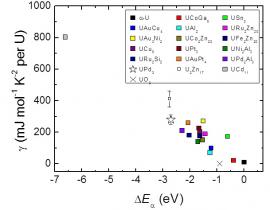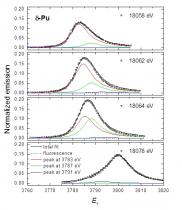The structural, electronic, and magnetic properties of U and Pu elements and intermetallics remain poorly understood despite decades of effort, and currently represent an important frontier of condensed matter physics. The last decade has seen great progress both due to the discovery of superconductivity in PuCoGa5 at 18 K1 and advances in theory that finally can explain fundamental ground state properties in elemental plutonium, such as the phonon dispersion curve, the non-magnetic ground state, and the volume difference between the α– and δ–phases.2 A new feature of the recent calculations is the presence not only of intermediate valence of the Pu 5f electrons, but of multiconfigurational ground states, where the different properties of the α– and δ–phases are primarily governed by the different relative weights of the 5f4, 5f5, and 5f6 electronic configurations.

Utilizing the new 7-crystal Johann-type spectrometer on BL 6-2 at SSRL, resonant x-ray emission spectroscopy (RXES) data have been collected by Corwin Booth (Lawrence Berkeley National Laboratory) and a team of researchers from Lawrence Berkeley, Los Alamos and Lawrence Livermore National Laboratories, and SSRL that show, for the first time, spectroscopic signatures of each of these configurations and their relative changes in PuSb2, α– and δ–Pu. In combination with similar data on UCd11 and UCoGa5, as well as conventional x-ray absorption near-edge structure (XANES) spectra on a wide variety of uranium and plutonium intermetallic compounds, these data indicate such states may be ubiquitous in uranium and plutonium intermetallics, providing a new framework toward understanding properties ranging from heavy fermion behavior, superconductivity, and intermediate valence to mechanical and fundamental bonding behavior in these materials.
The usual method for measuring multiconfigurational states in the lanthanides (Ln’s) is to measure the Ln LIII-edge XANES. When configurations differing by one electron exist, their energies are split by the core hole in the final state. The two resulting resonances are easily identified in XANES spectra because their energy separation is about 10 eV, while the broadening of the final state is only about 4 eV. The situation is reversed, however, for the actinides (An’s), where the splitting is expected to be about 4 eV, but the broadening is about 8 eV. Nevertheless, clear edge shifts are observed between many intermetallic U (Figure 1) and Pu compounds.

Advances in RXES have now allowed for spectra with sufficient resolution to resolve individual resonances associated with the various An valence states. In this experiment, the fluorescing La1 x-rays are resolved to better than 2 eV, allowing the individual configuration resonances to be separated as both a function of incident (EI) and emission (EE) photon energy. By taking advantage of the resonant characteristics of these features, the contribution of three configurations are clearly observed. By integrating the individual configuration contributions over both EI and EE, the normalized contribution from each configuration can now be obtained. For example, the contribution from each configuration in δ–Pu is, in fact, substantial: the 5f4, 5f5, and 5f6 contributions are 19%, 46%, and 35%. The weighted average (f-occupancy nf=5.28) is in reasonable agreement with DMFT calculation2 (nf=5.2).
This work opens the door to considering multiconfigurational ground states to explain other mysterious behavior in U and Pu materials, such as the hidden-order state in URu2Si2, or the nature of superconductivity in PuCoGa5. Also, as a fundamental property of U and Pu, these results are perhaps most important for understanding the nature of the relative importance of the delocalizing effect of relativity and the localizing effect of symmetry in 5f orbitals.
Work was supported by the Office of Science, Office of Basic Energy Sciences (OBES), of the U.S. Department of Energy (DOE) under Contract No. DE-AC02-05CH11231. X-ray data were collected at SSRL, a national user facility operated by Stanford University on behalf of the DOE, OBES.
- J. L. Sarrao Nature 420, 297 (2002).
- J. H. Shim, K. Haule, and G. Kotliar, “Fluctuating valence ina correlated solid and the anomalous properties of d–plutonium”, Nature 446, 513 (2007).
C. H. Booth, Yu Jiang, D. L. Wang, J. N. Mitchell, P. H. Tobash, E. D. Bauer, M. A. Wall, P. G. Allen, D. Sokaras, D. Nordlund, T.-C. Weng, M. A. Torrez, and J. L. Sarrao, “Multiconfigurational nature of 5f orbitals in uranium and plutonium intermetallics”, PNAS 109, 10205 (2012) doi: 10.1073/pnas.1200725109




